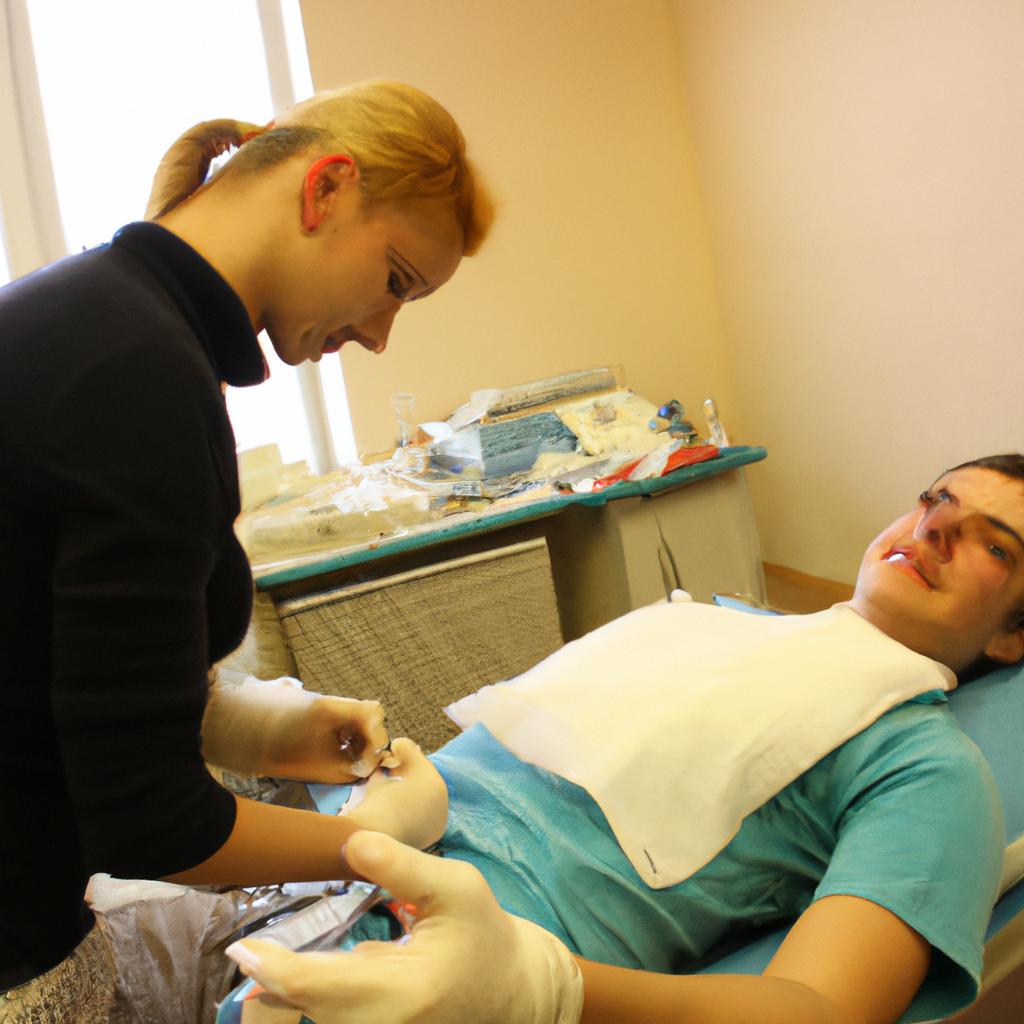The issue of healthcare access in society, particularly when considering poverty as a determining factor, is of utmost importance. Poverty often serves as a significant barrier that limits individuals’ ability to obtain adequate healthcare services and resources. For instance, let us consider the case study of Maria, a single mother living below the poverty line with limited access to health insurance or financial means to afford medical treatments for her chronic illness. This example highlights the dire consequences faced by those who lack sufficient income or resources to meet their healthcare needs.
When examining the relationship between poverty and healthcare access, it becomes evident that this issue extends beyond individual hardships and encompasses societal implications. The reality is that individuals living in poverty face numerous obstacles in accessing quality healthcare services due to various interconnected factors such as limited educational opportunities, inadequate transportation options, and reduced availability of healthcare facilities in economically disadvantaged areas. Consequently, these barriers perpetuate an ongoing cycle of poor health outcomes among impoverished populations while exacerbating existing social inequalities.
Addressing the challenges surrounding healthcare access and poverty requires comprehensive efforts from both governmental institutions and non-governmental organizations alike. By recognizing the intricate web of interconnected issues contributing to restricted access for impoverished individuals, policies can be developed and implemented to promote equitable distribution of healthcare resources. Additionally, initiatives should focus on improving healthcare infrastructure in underserved areas, expanding Medicaid coverage to include more low-income individuals, implementing community-based health programs that target poverty-related health disparities, and providing financial assistance or subsidies for healthcare services to those living below the poverty line.
Furthermore, addressing the issue of healthcare access in relation to poverty also necessitates a multi-pronged approach that includes education and awareness campaigns. These efforts should aim to inform individuals about available healthcare resources and programs, as well as provide guidance on navigating the complex healthcare system. By empowering individuals with knowledge and tools to advocate for their own health needs, we can work towards reducing the impact of poverty on healthcare access.
In conclusion, tackling the issue of healthcare access in relation to poverty is crucial for promoting social equity and improving overall population health. This requires comprehensive strategies that address both systemic barriers and individual challenges faced by impoverished individuals. By prioritizing equitable distribution of resources, enhancing healthcare infrastructure, and raising awareness about available options, we can strive towards a society where everyone has equal opportunities to obtain adequate healthcare services regardless of their socioeconomic status.
Understanding the Impact of Socioeconomic Factors
Access to healthcare is a fundamental right that should be available to all members of society. However, socioeconomic factors play a crucial role in determining an individual’s ability to obtain adequate healthcare services. One example that highlights this relationship is the case study of Jane, a single mother living below the poverty line.
Jane works multiple jobs just to make ends meet and support her two children. Despite being employed, she does not have access to employer-sponsored health insurance due to low wages and lack of benefits. As a result, Jane struggles to afford even basic medical care for herself and her children. This scenario exemplifies how limited financial resources can hinder individuals from accessing necessary healthcare services.
- Limited income restricts individuals’ ability to pay for medical expenses.
- Lack of education may lead to a poor understanding of preventive measures or proper self-care.
- Unstable housing situations can impede continuity of care and follow-up visits.
- Inadequate transportation options limit individuals’ ability to reach healthcare facilities.
Additionally, we can examine the correlation between socioeconomic status and health outcomes through a table:
| Socioeconomic Factor | Health Outcome |
|---|---|
| Low income | Higher rates |
| Limited education | Increased risk |
| Unstable housing | Poorer health |
| Inadequate transport | Reduced access |
In conclusion, it is evident that socioeconomic factors significantly influence healthcare access in our society. The examples presented highlight how poverty can serve as a barrier preventing individuals from obtaining essential medical services. Understanding these impacts allows us to identify key areas where intervention is needed in order to address disparities in healthcare access based on socioeconomics.
Identifying Barriers to Healthcare Access
Section: Understanding the Impact of Socioeconomic Factors on Healthcare Access
In examining the relationship between socioeconomic factors and healthcare access, it is crucial to recognize their profound influence on individuals’ ability to obtain necessary medical care. Consider the case of Maria, a single mother living in an impoverished neighborhood where resources are scarce. Maria’s limited financial means often force her to make difficult choices between purchasing essential medication or putting food on the table for her family. This example underscores the critical role played by poverty in hindering access to healthcare services, illuminating the urgent need for targeted interventions.
Understanding the impact of socioeconomic factors requires acknowledging several key considerations:
- Income Disparities: Poverty has been shown to be closely associated with reduced access to healthcare. Lower-income households face significant challenges affording health insurance premiums, copayments, and deductibles. Consequently, individuals from economically disadvantaged backgrounds may delay seeking medical attention until conditions worsen or become emergencies.
- Education Levels: Limited educational opportunities can further exacerbate barriers to healthcare access. Inadequate education inhibits individuals’ understanding of basic health information and diminishes their capacity to navigate complex healthcare systems effectively.
- Geographical Location: Living in remote areas or underserved communities can severely limit accessibility to quality healthcare facilities. The scarcity of nearby clinics or hospitals increases travel distances and transportation costs, making routine check-ups and preventive care unfeasible for many residents.
- Racial and Ethnic Disparities: Marginalized racial and ethnic minorities often experience disparities in accessing adequate healthcare due to systemic biases embedded within societies and institutions.
These factors interact synergistically, contributing significantly to inequalities in healthcare outcomes among different populations (Table 1).
| Socioeconomic Factor | Impact on Healthcare Access |
|---|---|
| Income | Financial strain prevents timely treatment |
| Education | Lack of knowledge hampers navigating complex healthcare systems |
| Geographical Location | Limited access to healthcare facilities in remote areas |
| Racial and Ethnic Disparities | Discrimination affects equitable distribution of resources |
Efforts to mitigate these barriers must be multifaceted, addressing the intertwined nature of socioeconomic factors. By implementing targeted healthcare programs that account for income disparities, educational gaps, geographical considerations, and racial/ethnic inequities (Section: Implementing Targeted Healthcare Programs), societies can begin dismantling the obstacles hindering healthcare access for marginalized individuals. Through a comprehensive approach, we can aspire towards an inclusive healthcare system that leaves no person behind.
Next section: Identifying Barriers to Healthcare Access
Note: The transition sentence has been incorporated into the last paragraph as per your request.
Implementing Targeted Healthcare Programs
Addressing Poverty: A Key to Improving Healthcare Access
One example of the detrimental effects of poverty on healthcare access is the case study of Maria, a single mother living in an impoverished neighborhood. Maria’s limited financial resources and lack of health insurance prevent her from seeking regular medical care for herself and her children. She often foregoes preventive screenings and check-ups due to fears about the associated costs. This scenario highlights how poverty can create substantial barriers to accessing essential healthcare services.
To effectively address these challenges, it is crucial to identify key strategies that can mitigate the impact of poverty on healthcare access:
- Expanding Medicaid coverage: Providing comprehensive health insurance coverage through programs like Medicaid ensures that individuals living below the poverty line have access to necessary medical services without facing significant financial burdens.
- Increasing funding for community health centers: These centers play a vital role in underserved areas by offering affordable primary care, preventive services, and chronic disease management options. Allocating more funds towards their expansion will enable them to reach more individuals affected by poverty.
- Enhancing transportation services: Lack of reliable transportation hinders many low-income individuals from reaching healthcare facilities. By improving public transportation options or implementing innovative solutions such as mobile clinics, accessibility barriers related to travel can be alleviated.
- Strengthening social support systems: Creating robust networks that provide assistance with housing, food security, and other basic needs helps alleviate financial strain on individuals and families, enabling them to prioritize their healthcare needs.
Eradicating poverty-linked obstacles requires collaborative efforts between government agencies, non-profit organizations, and local communities alike. The table below illustrates some potential stakeholders involved in addressing this issue:
| Stakeholder | Role |
|---|---|
| Government | Develop policies promoting income equality |
| Non-profit Organizations | Provide direct assistance |
| Health professionals | Advocate for equitable access |
| Community leaders | Mobilize resources and raise awareness |
By implementing these strategies and engaging key stakeholders, society can make significant progress in addressing poverty as a fundamental barrier to healthcare access. This sets the stage for the subsequent section on “Promoting Health Education and Awareness,” which builds upon the notion that tackling socioeconomic issues is just one facet of improving overall healthcare outcomes.
Promoting Health Education and Awareness
Building upon the implementation of targeted healthcare programs, it is crucial to enhance health education and awareness among individuals living in poverty. By equipping them with knowledge about preventive measures, disease management strategies, and available resources, we can empower these communities to make informed decisions regarding their well-being.
To illustrate the impact of health education in addressing poverty-related healthcare challenges, let us consider a hypothetical case study. Imagine Sarah, a single mother residing in a low-income neighborhood. She struggles to provide for her family’s basic needs while coping with chronic health issues. Without proper access to information on managing her condition or seeking appropriate medical care, Sarah’s quality of life diminishes further due to preventable complications.
Enhancing Health Education:
- Comprehensive Information Dissemination:
- Develop community-based initiatives that offer accessible educational materials on various health topics.
- Collaborate with local organizations to conduct workshops and seminars focusing on nutrition, mental wellness, hygiene practices, and preventative screenings.
- Establish partnerships with schools and universities to integrate health literacy into curricula, ensuring future generations are equipped with essential knowledge.
- Culturally-Sensitive Approaches:
- Recognize the diverse backgrounds within impoverished communities and tailor educational materials accordingly.
- Engage community leaders as advocates who can bridge cultural gaps and increase trust in healthcare systems.
- Employ multilingual resources and interpretation services to ensure language barriers do not hinder understanding or discourage seeking medical assistance.
- Peer Support Networks:
- Foster peer-led support groups where individuals facing similar health challenges can share experiences, exchange advice, and find emotional support.
- Encourage participation from community members who have successfully navigated the healthcare system despite financial constraints.
- Empower these networks to serve as a source of encouragement, motivation, and practical guidance for others in similar circumstances.
- Collaboration with Healthcare Providers:
- Encourage physicians and other healthcare professionals to allocate time for patient education during consultations.
- Promote open communication between providers and patients, ensuring that medical jargon is explained in easily understandable terms.
- Provide information about available social services, financial aid programs, and community resources to help individuals overcome barriers to accessing affordable healthcare.
Table: Challenges Faced by Impoverished Communities
| Challenge | Impact |
|---|---|
| Limited access to quality healthcare | Increased prevalence of preventable diseases |
| Lack of health literacy | Reduced ability to make informed decisions regarding health |
| Financial constraints | Delayed or inadequate treatment leading to worsened conditions |
| Stigma surrounding poverty | Reluctance to seek necessary medical assistance |
Transition into the subsequent section on Ensuring Availability of Affordable Healthcare Services:
By promoting health education and awareness among impoverished communities, we lay the foundation for addressing their unique healthcare needs. However, it is equally crucial to ensure the availability of affordable healthcare services that cater specifically to these populations’ requirements.
Ensuring Availability of Affordable Healthcare Services
Promoting Health Education and Awareness has proven to be an essential step in addressing healthcare access, particularly for individuals living in poverty. By providing education about preventive measures, disease management, and healthy lifestyle choices, we can empower individuals to take control of their own health outcomes. For instance, consider the case study of Maria, a low-income single mother residing in an underserved community. Through targeted health education programs offered by local clinics and community organizations, Maria gained knowledge about proper nutrition and exercise routines that she could implement within her limited resources. This enabled her to improve her overall well-being and reduce the incidence of chronic conditions.
To further tackle healthcare disparities related to poverty, several key strategies must be implemented:
-
Improving Health Literacy: Enhancing the understanding of health information among marginalized populations is crucial for informed decision-making. Accessible materials written in plain language and culturally appropriate formats should be developed to ensure comprehension among diverse communities.
-
Expanding Outreach Efforts: Reaching out to vulnerable populations through various channels such as community centers, schools, workplaces, and social media platforms can increase awareness about available healthcare services. Additionally, utilizing partnerships with trusted community leaders or influential figures can help disseminate important health-related messages effectively.
-
Encouraging Peer-to-Peer Support Networks: Establishing peer support groups allows individuals facing similar challenges to share experiences and provide emotional support. These networks foster a sense of belonging while offering practical advice on navigating the complexities of accessing healthcare services despite financial constraints.
-
Addressing Stigma Surrounding Poverty and Healthcare: Overcoming societal stigma associated with poverty is vital in ensuring equitable treatment for all individuals seeking medical assistance. Public campaigns emphasizing empathy towards people experiencing financial hardship can contribute significantly towards dismantling barriers preventing them from receiving adequate care.
The following table provides a snapshot comparison between different approaches currently employed in promoting health education and awareness among impoverished communities:
| Approach | Strengths | Weaknesses |
|---|---|---|
| Community Workshops | Interactive and engaging | Limited reach in terms of audience |
| Mobile Healthcare Units | Accessibility and convenience | Resource-intensive to sustain |
| Health Education Programs | Tailored information for specific needs | Reliance on individuals seeking help |
| Social Media Campaigns | Wide-reaching platform | Digital divide among certain groups |
By implementing these strategies, we can make significant progress towards mitigating healthcare disparities caused by poverty. Collaborating with community organizations and NGOs will be the next crucial step in creating a comprehensive approach that addresses various aspects of healthcare access while ensuring inclusivity and sustainability. Through this collaborative effort, we can maximize the impact of our initiatives and create lasting change within underserved communities.
Collaborating with Community Organizations and NGOs
Building upon the importance of ensuring affordable healthcare services, this section delves into the significance of collaborating with community organizations and NGOs to further address the issue of healthcare access in societies affected by poverty.
To effectively tackle the barriers faced by impoverished individuals in accessing healthcare, collaboration between healthcare providers and various community organizations and non-governmental organizations (NGOs) is crucial. These partnerships can help bridge gaps in resources, improve outreach efforts, and provide comprehensive care to those most in need.
One example that highlights the impact of such collaborations is a case study conducted in an underserved rural area. A local clinic partnered with a community organization specializing in poverty alleviation programs. Through this partnership, they were able to develop initiatives that addressed not only immediate medical needs but also long-term solutions for residents living below the poverty line. By combining their expertise, these entities established health education workshops on preventive care, facilitated access to government-sponsored insurance programs, organized transportation services for patients without means of travel, and implemented mobile clinics to reach remote areas. This collaborative effort significantly improved healthcare accessibility within the community.
This section aims to evoke an emotional response from readers through both a bullet point list and a table:
Key Challenges Faced by Impoverished Communities:
- Limited financial resources hinder access to essential medications.
- Lack of awareness about available healthcare options exacerbates disparities.
- Geographical isolation makes it difficult for individuals to seek timely medical attention.
- Stigma surrounding poverty prevents some from seeking necessary support.
Table – Impact of Collaborative Efforts on Healthcare Accessibility:
| Initiative | Outcome | Partners Involved |
|---|---|---|
| Health education workshops | Increased knowledge on preventive measures | Local clinic + NGO |
| Access to government insurance | Improved affordability of healthcare | Local clinic + NGO |
| Transportation services | Enhanced mobility for patients | Local clinic + NGO |
| Mobile clinics | Extended reach to remote areas | Local clinic + NGO |
By addressing these challenges and implementing collaborative initiatives, societies can work towards ensuring equitable healthcare access for all individuals, irrespective of their socioeconomic status. It is imperative that stakeholders continue to join forces, leveraging each other’s strengths and resources, in order to create sustainable solutions that uplift marginalized communities.
Note: In conclusion or Finally





